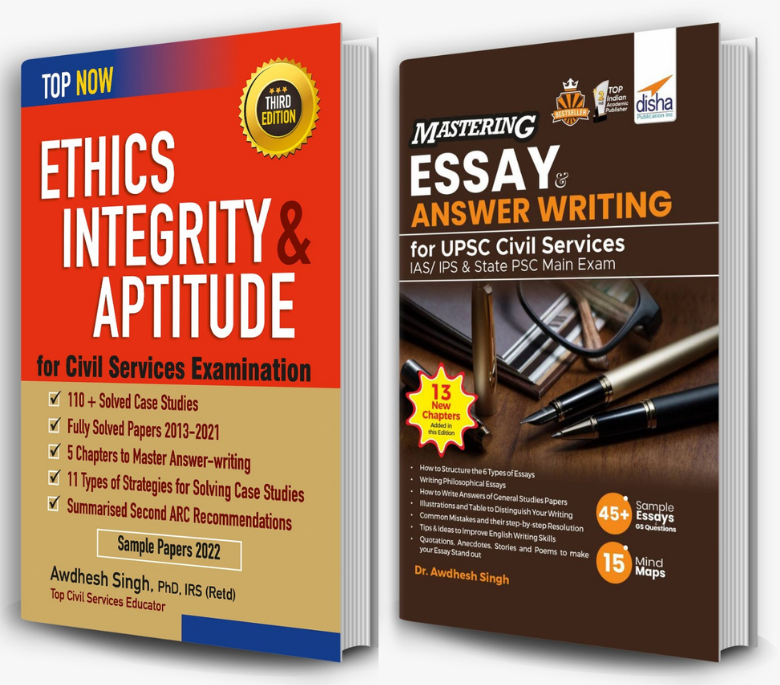Essay and Answer Writing → Model Essays
Topics
All
Civil Services in India (26)
Ethics, Integrity and Aptitude
» Chapters from Book (11)
» Case Studies (8)
Solved Ethics Papers
» CSE - 2013 (18)
» CSE - 2014 (19)
» CSE - 2015 (17)
» CSE - 2016 (18)
» CSE - 2017 (19)
» CSE - 2018 (19)
» CSE - 2019 (19)
» CSE - 2020 (19)
» CSE - 2021 (19)
» CSE -2022 (17)
» CSE-2023 (17)
Essay and Answer Writing
» Quotes (34)
» Moral Stories (18)
» Anecdotes (11)
» Beautiful Poems (10)
» Chapters from Book (5)
» UPSC Essays (40)
» Model Essays (38)
» Research and Studies (4)
Economics (NCERT) Notes
» Class IX (14)
» Class X (16)
» Class XI (55)
» Class XII (53)
Economics Current (51)
International Affairs (20)
Polity and Governance (61)
Misc (77)
Select Topic »

Civil Services in India (26)
Ethics, Integrity and Aptitude (-)
» Chapters from Book (11)
» Case Studies (8)
Solved Ethics Papers (-)
» CSE - 2013 (18)
» CSE - 2014 (19)
» CSE - 2015 (17)
» CSE - 2016 (18)
» CSE - 2017 (19)
» CSE - 2018 (19)
» CSE - 2019 (19)
» CSE - 2020 (19)
» CSE - 2021 (19)
» CSE -2022 (17)
» CSE-2023 (17)
Essay and Answer Writing (-)
» Quotes (34)
» Moral Stories (18)
» Anecdotes (11)
» Beautiful Poems (10)
» Chapters from Book (5)
» UPSC Essays (40)
» Model Essays (38)
» Research and Studies (4)
Economics (NCERT) Notes (-)
» Class IX (14)
» Class X (16)
» Class XI (55)
» Class XII (53)
Economics Current (51)
International Affairs (20)
Polity and Governance (61)
Misc (77)

Contempt of Court
Article 129 of the Indian Constitution of India states ‘The Supreme Court of India shall be a court of record and shall have all the powers of such a court including the power to punish for contempt of itself’. Recently the Supreme Court of India held noted advocate Prashant Bhushan guilty of ‘contempt of court’ in August 2020. His offence, according to the Supreme Court, were two tweets against present Chief Justice SA Bode and past four CJIs which the Supreme Court found was based on distorted facts and amounted to a ‘scurrilous and malicious attack on apex court and destabilised the foundation of the judiciary’. The essay lays out the meaning of contempt of court, its dimensions and how it has been used over the years.
What is contempt of court?
Contempt of Court is a constitutional power vested with the Supreme Court of India. It is an offence of disobedience or disrespect towards a court of law and its officers in the form of conduct that opposes or challenges the authority, justice, and dignity of the court. The principal aim of the jurisdiction is to protect the dignity of the court and the due administration of justice. The Contempt of Court Act, 1971 under Section 2(c) defines and limits the powers of certain courts in punishing contempt of courts.
According to the Contempt of Courts Act, 1971, contempt of court can either be:
·Civil contempt - civil contempt means wilful disobedience to any judgment, decree, direction, order, writ or other process of a court or wilful breach of an undertaking given to a court.
·Criminal contempt - criminal contempt means the publication (whether by words, spoken or written, or by signs, or by visible representations, or otherwise) of any matter or the doing of any other act whatsoever which scandalises or tends to scandalise, or lowers or tends to lower the authority of, any court; or prejudices, or interferes or tends to interfere with, the due course of any judicial proceeding; or interferes or tends to interfere with, or obstructs or tends to obstruct, the administration of justice in any other manner.
A contempt of court may be punished with simple imprisonment for a term which may extend to six months, or with fine which may extend to two thousand rupees, or with both, provided that the accused may be discharged or the punishment awarded may be remitted on apology being made to the satisfaction of the court. A similar attitude towards a legislative body is termed contempt of Parliament or contempt of Congress.
Which offences get tagged as contempt?
Innocent publication, distribution of matter and reasonable and fair criticism of judicial acts and comments on the administrative side of the judiciary does not amount to contempt of the court. What then amounts to contempt of court?
·Interference with Administration of Justice: In Brahma Prakash Sharma vs State of Uttar Pradesh, the Supreme Court had held that it was not necessary to specifically prove that an actual interference with administration of justice has been committed. The Court held that it was enough if a defamatory statement is likely or in any way tends to interfere with the proper administration of justice.
·Scandalising the Court: In PN Dua vs Shiv Shankar and others, the Supreme Court held that mere criticism of the Court does not amount to contempt of Court. It observed that in a free democracy, criticisms about the judicial system are welcomed, so long as such criticisms do not impair or hamper the administration of justice. The Court will also have to consider the degree of harm caused as affecting administration of justice.
·Interference with due course of Justice: In Pritam Lal vs High Court of M.P the Supreme Court held that to preserve the proceedings of the Courts from interference and to keep the streams of justice pure, it becomes the duty of the Court, to punish the in order to preserve its dignity.
The Court has clarified that any citizen can comment or criticise the judgment of the Court. However, that citizen must have some standing or knowledge before challenging the ability, integrity, and impartiality of a Judge of the highest court of the land.
Recent example
Coming back to Prashant Bhushan’s case, his first tweet was about a picture of Chief Justice SA Bobde sitting on a high-end bike. In the second tweet, Prashant Bhushan offered an opinion on the role played by the last four Chief Justices of India in the country’s current situation. Before pronouncing a sentence, the court had given Bhushan three chances to tender an unconditional apology but Bhushan through his own statement and through his lawyers said he stood by his tweets and was not asking for any leniency, mercy or magnanimity from the court.
Finally, a bench headed by Justice Arun Mishra sentenced Bhushan to a token fine of Rs 1/- which if he failed to pay by the stipulated period of time would lead to imprisonment of three months and a practice ban of three years.
Why Bhushan was held guilty?
·The SC said the tweets brought the administration of justice into disrepute and undermined the dignity and authority of the institution of Supreme Court and the office of the Chief Justice of India in the eyes of the public at large.
·When he was asked to explain his tweets, Bhushan refused to apologise and said he stood by his tweets and said if it is construed as contempt and proceedings continued, it would stifle free speech and would constitute an unreasonable restriction on Article 19 that is freedom of speech and expression.
Criticism
The reason why the concept of contempt exists is to insulate the Courts from unfair criticism and prevent a fall in the judiciary’s reputation in the public eye. However, it has raised the dilemma between the part of contempt law that criminalises anything that “scandalises or tends to scandalise” the judiciary and freedom of speech and expression. The the current issue has once again brought under focus the need for reviewing the law.
·A law for criminal contempt gets in conflict with India’s democratic system which recognises freedom of speech and expression as a fundamental right.
·The definition of criminal contempt is extremely wide, and can be easily invoked.
·It has been made obsolete in foreign democracies, with jurisdictions recognising that it as an archaic law: The Contempt Law in England has now been abolished after the last contempt proceedings occurred in 1930.
Conclusion
The truth is of course that public institutions in a free society must stand upon their own merits: they cannot be propped up if their conduct does not command the respect and confidence of the community; if their conduct justifies the respect and confidence of a community they do not need the protection of special rules to protect them from criticism.
Time and again, the Contempt of Court law has been criticised for stifling dissenting voices. However, its supporters have pointed out that abolishing the offence in India would leave a legislative gap. There are a high number of civil and criminal contempt cases pending in various High Courts and the Supreme Court. What is required is the need to retain the provision but by revising and tightening its definition.
(Sources: indianexpress.com / doj.gov.in / Wikipedia.com)

Looking for a One-stop Solution to prepare for ‘Ethics, Integrity, and Aptitude’ and ‘Essay and Answer Writing’ for UPSC?
Buy Dr. Awdhesh Singh’s books from the links below-
Ethics, Integrity & Aptitude for Civil Services Examination
Amazon - https://amzn.to/3s1Qz7v
Flipkart - https://bit.ly/358N2uY
Mastering Essay & Answer Writing for UPSC Civil Services
Amazon - https://amzn.to/3JELE2h
Flipkart - https://bit.ly/3gVIwmv
| Related Articles |
| Recent Articles |
